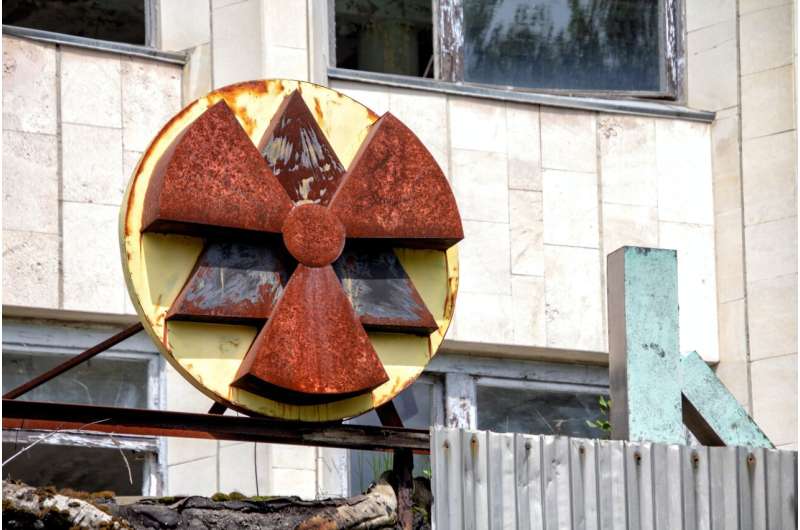
The catastrophic disaster at the Chernobyl Nuclear Power Plant in 1986 was caused by an explosion at the Reactor 4 Unit. This expelled a sizeable quantity of radioactive material into the surroundings, alongside a partial meltdown of the reactor core. The last few decades have seen substantial international efforts to safely contain and decontaminate the site, including the recent installation of the New Safe Confinement structure.
But Russian forces have now seized the site, along with the Zaporizhzhia nuclear power plant, as part of the ongoing conflict in Ukraine. Moreover, on March 9, Ukrainian authorities reported a power loss at Chernobyl, followed by a partial one at Zaporizhzhia.
Despite reassurances by the International Atomic Energy Agency (IAEA) that there is no imminent safety threat posed by the power isolation, it is important to understand the potential impact going forward.
When nuclear fuel is removed from the core of a reactor, it is redesignated as “spent” nuclear fuel and often treated as a waste product for disposal.
But fuel will continue to dissipate heat due to radioactive decay, even after being removed from the reactor core. It is therefore of foremost importance that the spent fuel material contained at the Chernobyl site is adequately and continuously cooled to prevent a release of radioactivity.
At Chernobyl, as well as other sites, standard procedures to safely handle such material involves placing the fuel into water-filled ponds, which shield the near-field environment from radiation. They also provide a medium for heat transfer from the fuel to the water via continuous circulation of fresh, cool water.
If circulation is compromised, such as the recent power shutdowns, the fuel will continue to emit heat. This can make the surrounding coolant water evaporate—leaving nothing to soak up the radiation from the fuel. It would therefore leak out to the surroundings.
In the case of Chernobyl, the spent fuel material has been out of the reactor for an adequate period of time and does not, therefore, require intensive cooling. However, the surrounding water could nevertheless be evaporated eventually if the power is not reinstated. This could, in turn, heighten the risk for an increased radiation dose uptake by the remaining site workers and beyond.
The remaining risks are mainly posed by the severely damaged Reactor 4 Unit, which contains sizeable quantities of a lava-like material, commonly referred to as “corium” (because it comes form the core). This is highly radioactive and its eventual disposal continues to present a substantial scientific and engineering challenge. It is therefore necessary that the continued operation of radiation monitoring and ventilation systems within the New Safe Confinement structure remain online.
At Zaporizhzhia, two out of six reactors are actually operating. The damaged power connection luckily affects a reactor that is currently shut down. This is undergoing repair—but it is difficult to get spare parts in the middle of the war.
Nervous wait
Despite assurances that there exist on-site reserves of diesel fuel that could feasibly provide back-up power for approximately 48 hours at Chernobyl, we don’t know how long the site will be without power. It should be reiterated, however, that IAEA have said there is no cause for immediate alarm. That’s because there is enough water in the spent fuel pools to avoid an accident. It may be months before the water is completely gone.
This is reassuring, but then the fighting in the region is reportedly already making it difficult to fix the power connection problem.
At Zaporizhzhia, the damaged power connection is undergoing repair—but it is difficult to get spare parts in the middle of a war. The fact that the reactor is shut down means it is not an immediate safety risk. But if power is cut to one of the operating reactors, paired with substantial damage to backup generators, this could result in meltdown in the worst case.
The safe dismantling, decontamination and decommissioning of the Chernobyl site is the collective aim of the global engineering community, yet estimates of completion range into the late 2060s. Clearly, the latest events events pose a serious threat to the ongoing decommissioning efforts in Ukraine.
Russian shelling caused a fire at a Ukrainian nuclear power plant. How close did we actually come to disaster?
This article is republished from The Conversation under a Creative Commons license. Read the original article.![]()
Citation:
Chernobyl and Zaporizhzhia power cuts: Nervous wait as Ukraine nuclear power plants could start leaking radiation (2022, March 10)
retrieved 10 March 2022
from https://techxplore.com/news/2022-03-chernobyl-zaporizhzhia-power-nervous-ukraine.html
This document is subject to copyright. Apart from any fair dealing for the purpose of private study or research, no
part may be reproduced without the written permission. The content is provided for information purposes only.
Stay connected with us on social media platform for instant update click here to join our Twitter, & Facebook
We are now on Telegram. Click here to join our channel (@TechiUpdate) and stay updated with the latest Technology headlines.
For all the latest Technology News Click Here
For the latest news and updates, follow us on Google News.
